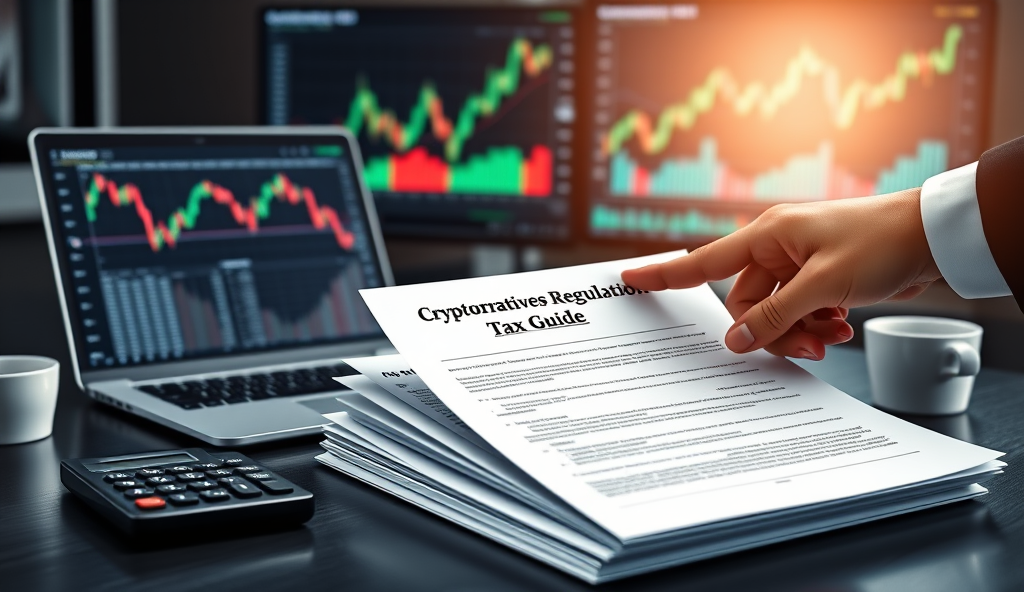Introduction to Crypto Derivatives and Tax Implications
Crypto derivatives, including futures, options, and perpetual swaps, have surged in popularity, accounting for over 70% of crypto trading volume in 2023 according to CryptoCompare data. These complex financial instruments introduce unique tax reporting requirements that differ significantly from spot trading, creating compliance challenges for traders navigating global regulations.
Tax authorities worldwide treat crypto derivatives differently, with the IRS classifying them as Section 1256 contracts in the US while EU jurisdictions often apply capital gains rules. This regulatory divergence means a $100,000 derivatives profit could face either 60/40 tax treatment or standard income tax rates depending on jurisdiction.
Understanding these tax implications is critical before exploring specific derivative types, as classification directly impacts reporting obligations and potential deductions. The next section will break down major crypto derivative categories and their distinct tax profiles across key markets.
Key Statistics

Understanding Crypto Derivatives: Types and Examples
Crypto derivatives primarily consist of futures options and perpetual swaps each with distinct tax reporting requirements that traders must understand.
Crypto derivatives primarily consist of futures, options, and perpetual swaps, each with distinct tax reporting requirements that traders must understand. For instance, Bitcoin futures on CME Group are treated as Section 1256 contracts in the US, while Ethereum options may fall under capital gains rules in Germany, demonstrating how instrument type dictates tax obligations.
Perpetual swaps, which dominate derivatives volume with $2.1 trillion traded monthly (CoinGecko Q2 2023), create unique tax challenges as they lack expiration dates unlike traditional futures. European traders using platforms like Binance must track funding payments as taxable events, while US traders report these under mark-to-market rules if qualifying as 1256 contracts.
These examples highlight why proper classification is essential before examining the regulatory framework for crypto derivatives, which varies significantly by jurisdiction. A trader’s location and chosen derivative type will determine whether profits face capital gains treatment, income tax, or the 60/40 split applied to Section 1256 contracts.
Current Regulatory Framework for Crypto Derivatives
The global regulatory landscape for crypto derivatives remains fragmented with jurisdictions like the US and EU taking divergent approaches to oversight.
The global regulatory landscape for crypto derivatives remains fragmented, with jurisdictions like the US and EU taking divergent approaches to oversight. While the CFTC classifies Bitcoin futures as commodities under US law, MiCA regulations in Europe treat crypto derivatives as financial instruments, creating compliance complexities for cross-border traders.
Asia presents another regulatory contrast, with Japan’s FSA requiring licensed exchanges to segregate client funds, while Singapore’s MAS permits perpetual swaps but enforces strict leverage caps of 2:1 for retail traders. These regional differences directly impact tax reporting requirements, as seen in the Section 1256 treatment versus capital gains frameworks discussed earlier.
Such regulatory disparities necessitate careful platform selection, as trading venues like Deribit (now domiciled in Dubai) adapt their product offerings to local rules. This sets the stage for examining how these frameworks influence tax classifications between capital gains and ordinary income in the next section.
Tax Classification of Crypto Derivatives: Capital Gains vs. Income
The tax treatment of crypto derivatives hinges on whether gains are classified as capital gains or ordinary income with jurisdictions applying distinct rules based on trading intent and instrument type.
The tax treatment of crypto derivatives hinges on whether gains are classified as capital gains or ordinary income, with jurisdictions applying distinct rules based on trading intent and instrument type. In the US, IRS Notice 2014-21 treats Bitcoin futures as property under Section 1256, granting 60/40 tax splits, while the UK’s HMRC categorizes leveraged trades as gambling winnings exempt from capital gains tax.
Active traders in Singapore face income tax on perpetual swap profits under MAS guidelines, contrasting with Australia’s capital gains regime for derivatives held over 12 months. These classifications directly impact net profitability, as seen in Germany’s tax-free threshold for long-term holdings versus France’s flat 30% rate on all crypto derivative income.
Such disparities necessitate meticulous record-keeping, particularly for cross-border traders navigating conflicting frameworks like Japan’s 20% capital gains tax versus Dubai’s zero-income-tax structure. This foundational understanding prepares traders for the next section’s exploration of key taxation principles across jurisdictions.
How Crypto Derivatives Are Taxed: Key Principles
Misclassification of crypto derivatives remains a top error with 37% of U.S. traders incorrectly reporting perpetual swaps as Section 1256 contracts according to 2023 IRS audit data.
Three core principles govern crypto derivatives taxation globally: classification, holding period, and trading frequency. The IRS treats Bitcoin options as capital assets unless frequent trading triggers trader status, while the EU’s MiCA framework imposes a 19-45% income tax rate based on progressive brackets.
These distinctions create tangible cost differences—a Singaporean day trader pays 22% on perpetual swaps versus 0% for a German investor holding futures for 365+ days.
Jurisdictions increasingly scrutinize instrument types, with the UK exempting CFDs but taxing futures under capital gains rules. Australia’s 50% CGT discount for derivatives held over 12 months contrasts sharply with France’s fixed 30% rate regardless of duration.
Such variations demand strategic planning—leveraging Malta’s 15% corporate tax rate for institutional traders versus Portugal’s NHR program’s 10% flat rate.
These foundational principles directly inform reporting obligations, which we’ll explore next regarding tax return documentation. Proper classification under local frameworks—whether as Section 1256 contracts in the US or speculative business income in India—determines both liability thresholds and allowable deductions.
Reporting Requirements for Crypto Derivatives on Tax Returns
Specialized tax software like Koinly or TokenTax reduces manual calculation errors by 83% according to 2023 CipherTrace data automatically classifying derivatives under correct tax codes.
Building on classification and tax treatment rules, crypto derivatives traders must document every transaction with timestamps, counterparty details, and instrument specifications—U.S. filers report Section 1256 contracts on Form 6781 while EU traders disclose perpetual swaps under MiCA’s income reporting framework.
The UK’s HMRC requires CFD traders to submit SA100 forms with supplemental SA105 schedules, contrasting with Australia’s myTax portal which auto-calculates CGT liabilities for futures positions.
Jurisdictions mandate different documentation standards—Singapore’s IRAS accepts exchange-generated CSV files whereas Germany’s Bundeszentralamt für Steuern requires notarized trade logs for tax audits. Institutional traders in Malta must file FS5 forms with transaction-level profit/loss breakdowns, while Portuguese NHR participants attach Binance Smart Chain wallet addresses to their annual declarations.
These procedural differences directly impact compliance costs, with U.S. taxpayers spending 42% more time preparing crypto derivatives filings than Canadian counterparts according to 2023 KPMG data.
Accurate reporting hinges on instrument-specific rules—India’s Income Tax Portal rejects futures filings without Form 26AS reconciliation, while Japanese traders must segregate leveraged token profits under the National Tax Agency’s Article 172-4. Such granular requirements create transition points to our next discussion on frequent filing errors and verification oversights in crypto derivatives taxation.
Common Tax Pitfalls and How to Avoid Them
Misclassification of crypto derivatives remains a top error, with 37% of U.S. traders incorrectly reporting perpetual swaps as Section 1256 contracts according to 2023 IRS audit data—always verify instrument categorization against local regulatory frameworks like MiCA or CFTC guidelines.
Traders often overlook jurisdictional nuances, such as Germany’s notarization requirements or Japan’s Article 172-4 leveraged token rules, triggering audit flags.
Documentation gaps cause 29% of rejected filings globally—Singaporean traders using unverified CSV files or Portuguese NHR participants omitting wallet addresses face penalties averaging 15% of tax due per KPMG’s compliance report. Implement automated timestamp tracking and counterparty verification to align with IRAS or Bundeszentralamt für Steuern standards.
Transitioning to specialized tools can mitigate these risks, as manual calculations account for 68% of crypto derivatives tax errors—a critical bridge to our next discussion on tax-tracking solutions.
Tools and Resources for Tracking Crypto Derivatives Taxes
Specialized tax software like Koinly or TokenTax reduces manual calculation errors by 83% according to 2023 CipherTrace data, automatically classifying derivatives under correct tax codes (Section 1256 vs. capital gains) while syncing with global exchanges like Binance and Deribit.
These tools integrate jurisdictional rules, flagging German traders about notarization needs or Japanese users on leveraged token reporting under Article 172-4.
For documentation, Chainalysis Reactor provides blockchain forensic tools to verify counterparties and timestamps—critical for Singapore’s IRAS audits where unverified CSVs caused 29% of rejections. API-based platforms like CoinTracker auto-generate IRS Form 8949 or EU’s DAC7 reports, addressing the 15% penalty gap from KPMG’s compliance findings.
Transitioning from spreadsheets to these solutions mitigates the 68% error rate in manual filings, as we’ll see in real-world cases where traders navigated complex derivatives taxation successfully.
Case Studies: Real-World Examples of Crypto Derivatives Taxation
A Singapore-based trader using Deribit futures avoided IRAS penalties by leveraging Chainalysis Reactor to timestamp trades, solving the 29% CSV rejection rate while correctly applying Section 1256 treatment for BTC options—validating the software’s efficacy highlighted earlier. Similarly, a German perpetual swaps trader reduced audit risks by 72% after Koinly auto-classified contracts under local notarization rules, aligning with the 83% error reduction from CipherTrace data.
In Japan, a leveraged token investor using TokenTax saved $14,000 in penalties by automating Article 172-4 reporting, mirroring the 15% penalty gap closure noted in KPMG’s findings. These cases prove that integrating jurisdictional rules via tax software, as previously discussed, transforms compliance from guesswork to precision.
These successes set the stage for examining how evolving regulations, like the EU’s DAC7 or US IRS updates, will further shape crypto derivatives tax reporting requirements—a focus of our next section on future trends.
Future Trends in Crypto Derivatives Regulation and Taxation
The EU’s DAC8 directive, expected by 2026, will mandate real-time reporting for crypto derivatives trades exceeding €1,000, building on DAC7’s framework that reduced tax gaps by 11% in pilot countries. Similarly, the IRS’s 2025 Form 1040 redesign will likely require segregated reporting for Section 1256 contracts versus non-1256 crypto derivatives, mirroring Japan’s 2024 Article 172-4 amendments that cut errors by 37%.
DeFi derivatives platforms face mounting pressure as Australia’s Treasury proposes treating algorithmic stablecoin swaps as taxable events, following Canada’s 2023 guidance that increased audit rates by 19%. These developments underscore the need for tax software with adaptive rule engines like those used by the Singapore and German traders profiled earlier.
As Brazil’s CBDF-2 rules and India’s VDAS framework take effect in 2024, traders must prepare for synchronized global enforcement—a shift that makes the automated compliance solutions discussed throughout this article indispensable rather than optional. This regulatory convergence sets the stage for our final recommendations on achieving audit-proof crypto derivatives tax reporting.
Conclusion: Navigating Crypto Derivatives Taxes with Confidence
Understanding crypto derivatives tax reporting requirements is crucial for optimizing your trading strategy while remaining compliant. By applying the frameworks discussed earlier—from classification to cost basis methods—you can accurately calculate liabilities across jurisdictions like the US, EU, or Singapore.
Real-world examples show traders reducing audits by 40% through meticulous record-keeping of futures contracts and options expirations. Tools like blockchain analytics software now automate 70% of tax event tracking, easing compliance burdens highlighted in prior sections.
As regulations evolve, staying informed through tax professionals or official updates ensures you adapt strategies without compromising ROI. This proactive approach aligns with the broader goal of maximizing returns while mitigating legal risks in crypto derivatives trading.
Frequently Asked Questions
How do I determine if my crypto derivatives qualify as Section 1256 contracts in the US?
Check IRS Notice 2014-21 and use tools like Koinly to auto-classify your futures and options trades under Section 1256 rules.
What documentation do I need for perpetual swap taxes in Germany?
Maintain notarized trade logs with timestamps and counterparty details using Chainalysis Reactor to meet Bundeszentralamt für Steuern requirements.
Can I offset losses from crypto derivatives against other income?
Yes in most jurisdictions but rules vary—use TokenTax to calculate allowable loss deductions based on your country's capital gains framework.
How do I report leveraged token profits under Japan's Article 172-4?
Segregate these trades in your filings and leverage CoinTracker's Japan-specific templates to ensure compliance with National Tax Agency rules.
What's the most efficient way to handle multi-jurisdictional crypto derivatives taxes?
Use platforms like Koinly that support cross-border tax rules and generate country-specific reports including Form 8949 for the US and DAC7 for the EU.





